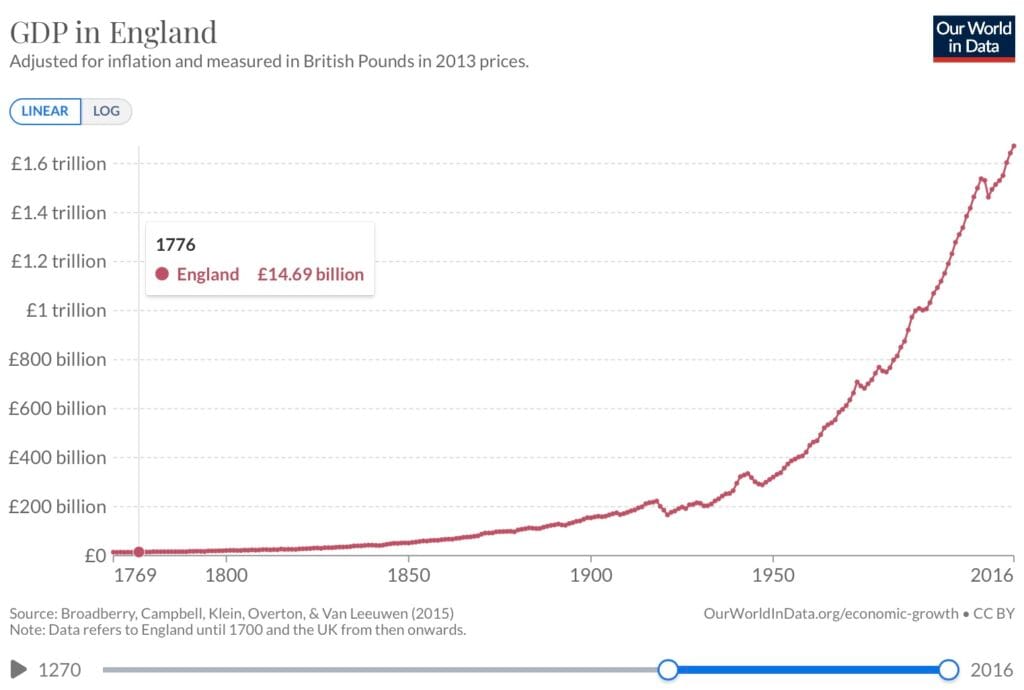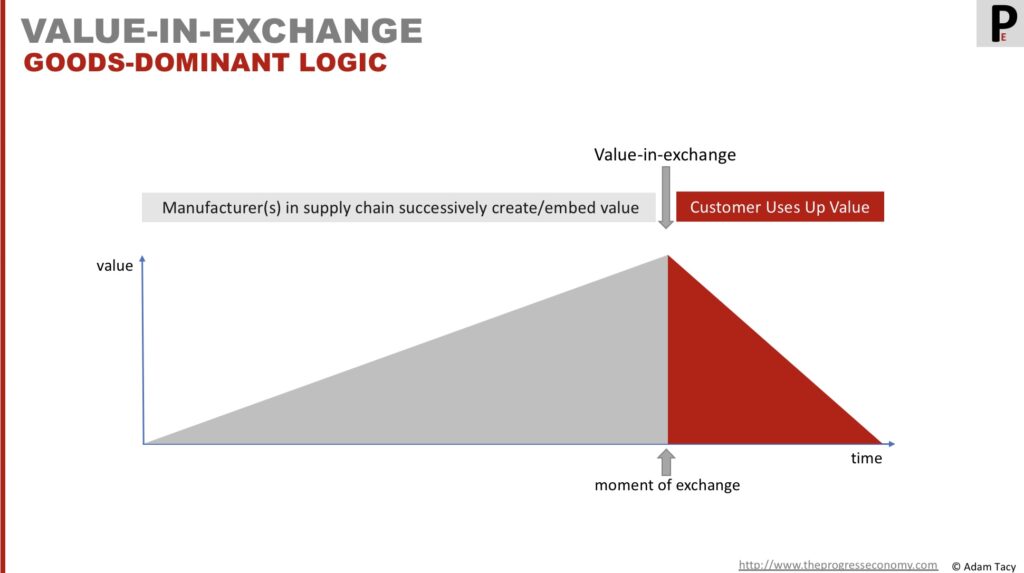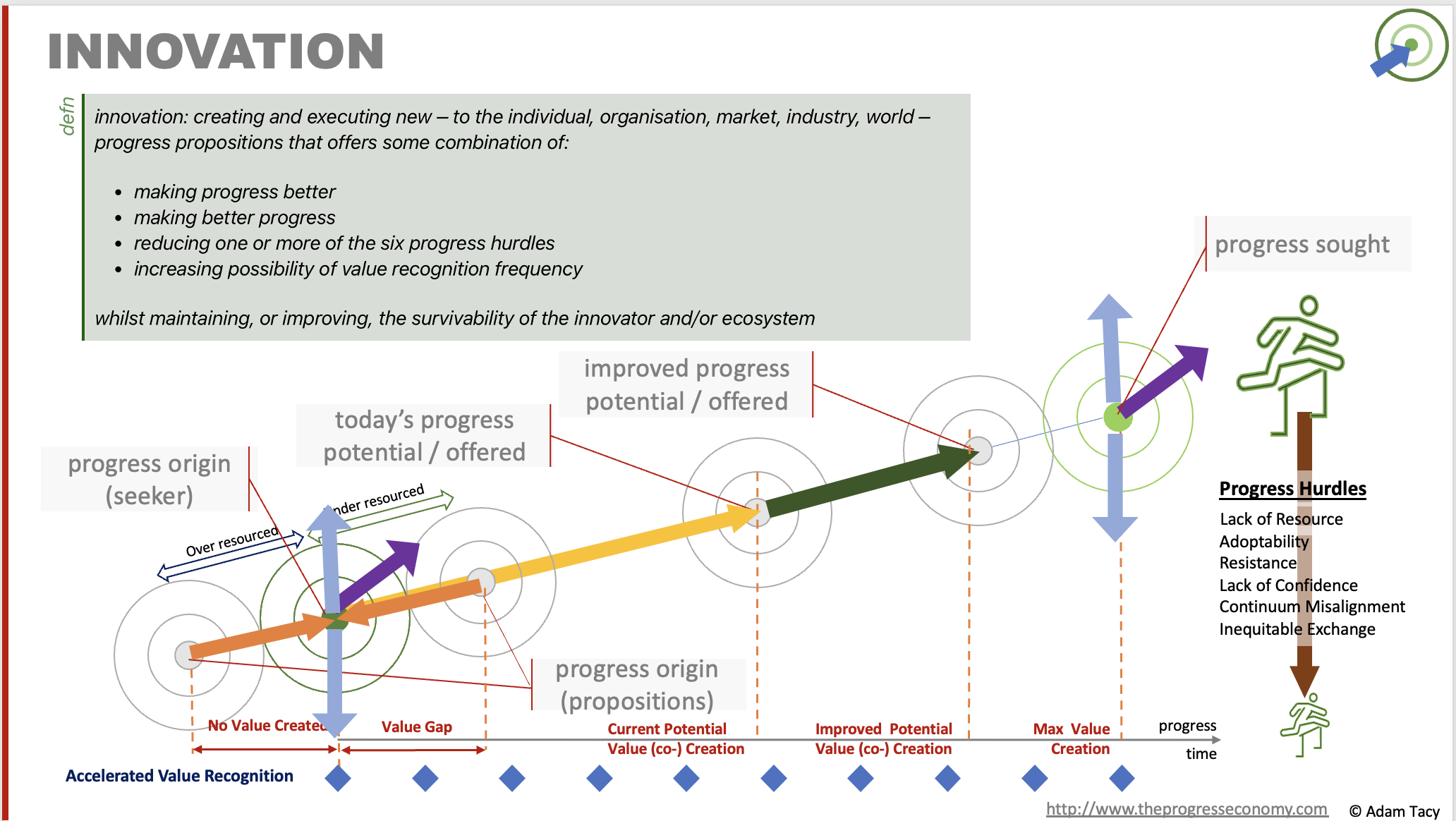Beyond Value Podcast Episode:
Innovation currently disappoints. Basing innovation on chasing value is the fundamental reason. Are you ready to re-build on “enabling progress”?
What we’re thinking
We have an innovation problem where, not least, 94% of executives are unhappy with innovation initiatives and the IMF tell us we’re in the tepid twenties in terms of growth.
Why? Our definitions of, and approaches to, innovation are based around creating or adding value. But we know that value is hard to define and our typical model of value (value-in-exchange) has blindspots that we are increasingly hitting. It should not be a surprise our innovation efforts struggle if we base them on value.
The innovation problem is structural: the wrong endgame (adding value), the wrong mental model (value-in-exchange), and the wrong success lens (supplier-centric rather than Seeker-centric).
We need to shift away from “adding value” toward enabling progress – a perspective that makes innovation operational, measurable, actionable, and successful.
innovation: creating and executing new – to the individual, organisation, market, industry, world – progress propositions that offers some combination of:
- making today’s progress better
- making better progress towards progress sought than possible today
- reducing one or more of the six progress hurdles
- increasing possibility of value recognition frequency
whilst maintaining, or improving, the survivability of the innovator and/or ecosystem
And we’ll find that sales and innovation are two sides of the same coin.
Innovation
In this post, we’re going to look at three key aspects:
- How we typically see innovation today – anchored to the idea of “adding value” – and why we need innovation
- Why chasing value so often leads to disappointment
- And how the Progress Economy adresses our innovation problem by reframing innovation as the act of enabling better progress.
Innovation, whether incremental, radical, or disruptive, has always been central to firm growth, organisational vitality, and wider economic prosperity. For centuries, tying innovation to the pursuit of “adding value” has served us well. It helped build industries, fuel competition, and deliver prosperity.
But the model is now showing strain. Growth has stagnated in many sectors. Innovation success rates have declined. Executives remain frustrated by the poor returns on time, energy, and capital invested in innovation programmes that promise much but deliver little.
The problem lies in what we’re chasing. “Value” is difficult to define, measure, or agree upon, which makes it a poor foundation for innovation.
In the Progress Economy, innovation is about enabling better progress.
That means understanding Seekers’s progress sought – the more desirable state they want to reach – and their origin – where they are now. As well as the hurdles that limit their current progress. Innovation becomes the disciplined discovery and deployment of new ways to help Seekers make better progress with lower hurdles and quicker value recognition.
Such a view reveals a set of progress levers that leaders can systematically apply to improve innovation success rates – dramatically increasing the odds that effort converts into outcomes.
Finally, this progress-first lens also dissolves an artificial boundary many organisations don’t realise they hold: the divide between innovation and sales. Both exist to help Seekers make progress. One operating more “off-line” to design new ways of helping, the other operating “in-line” to match those ways to real Seekers in real contexts. In fact, sales interactions often generate local innovations and market intelligence that, when captured, can directly strengthen innovation upstream.
Let’s start, then, with a foundational question: why do we innovate?
Why innovate?
Why do we innovate in the first place? The answer is multi-layered, with innovation occurring at both the individual and firm levels.
Individuals innovate to create value for themselves – to achieve what they currently cannot, or to do something they already do, but better. They may generate new things, re-use things, and/or combine things in novel ways to achieve that. Subsequently, they may attempt to capture value by selling their innovations (the value-in-exchange model in action), perhaps becoming a firm themselves.
Firms, and organisations, innovate to create a customer.
To create a customer
Firms innovate, as Drucker tells us, to create a customer. That is, to elicit an exchange of value – cash for products. They create products, services, and processes that they believe hold better value for their customers than competitors.
because the purpose of a business is to create a customer, the business enterprise has two – and only two – basic functions: marketing and innovation
p. drucker
Defining “better” and “value” is challenging. In theory, marketing identifies customer needs; innovation creates novel solutions to meet them. Which is why Drucker sees those as the two basic functions of a business (everything else is a cost). However, consider your innovation activities, how often is the marketing aspect missing, or undefined (perhaps with the thought that innovation is creativity that comes from employees)? And we’ve seen that value is hard to define.
Traditionally, innovation embeds additional value into products, which is then monetised through higher prices or greater volume (depending upon your positioning relating to Porter’s strategy). In short: the purpose of innovation has long been framed as increasing value.
McKinsey reflect that by noting 84% of executives see innovation as important to growth, but that statistic only scratches the surface.
84% of executives see innovation as important to growth
McKinsey
Firms also have a survival imperative.
Innovate or Die
While motivation explains why we innovate, Drucker also gave us a warning underscoring urgency for firms: innovate or die.
innovate or die
p. drucker
We have seen this play out many times.
Blockbusters failed to innovate its business model, clinging to charging late fees while Netflix grew, overtook and outlives them.
Kodak invented digital photography but failed to realign its propositions around customers’ emerging need: instant, shareable images rather than printed photos. The result was catastrophic. Kodak lost its dominant position and filed for bankruptcy, despite holding the very technology (digital cameras, photo sharing site) that shaped the future.
The same pattern plays out in B2B markets. Many traditional ERP vendors were slow to respond to the shift toward cloud-based solutions that offered more flexible, scalable, and lower-maintenance ways for businesses to make progress. SaaS challengers rapidly captured market share, leaving incumbents scrambling to reinvent their propositions – often at far greater cost than if they had acted earlier.
This does not mean you must be first. Apple has been a strong pointer that being a fast follower is a successful playbook.
Executives face a universal truth: innovate, or risk obsolescence.
For macro-growth
So, we innovate to both create customers and sustain organisational viability. Innovation keeps a business relevant and competitive; without it, advantage erodes and decline begins. In this sense, innovation drives local growth. it fuels firm-level expansion, new revenue streams, and improved productivity.
Brusoni, Cefis, and Orsenigo point out that drawing a link between successful innovation and GDP growth id treated as a truism in their 2006 paper “Innovate or Die? A critical review of the literature on innovation and performance“. (Though they found little empirical evidence of this). And we can certainly see explosive growth in GDP in the past. Below you can see that in the figures from England from the time of Adam Smith’s “Wealth of nations” that identified value-in-exchange as the driver for growth and near modern times.

Sveriges Riksbank Prize in Economic Sciences in Memory of Alfred Nobel 2025 awarded to Joel Mokyr, Philippe Aghion and Peter Howitt:
Nobel Prize Organisation
“for having explained innovation-driven economic growth“
Joseph Schumpeter described that growth comes through creative destruction: the process by which new technologies and business models render old ones obsolete while expanding the overall economy. Each wave of innovation destroys some industries but gives rise to new ones with greater productivity and societal benefit.
This link between innovation and long-term economic growth continues to shape our understanding of prosperity. Indeed, the 2025 Nobel Prize in Economics was awarded to three researchers “for having explained innovation-driven economic growth,” recognising that the cumulative effects of innovation, across firms, industries, and nations, are the foundation of modern economic advancement.
What then is innovation?
Defining innovation – adding/creating value
We usually define innovation around adding or creating value (a value-in-exchange mindset). This has driven centuries of economic growth and built entire industries.
For example, ISO’s 2025 definition of innovation is “a new or changed entity, realising or redistributing value”:
Innovation: new or changed entity1, realizing or redistributing value2
ISO 56000 (2025) – Innovation Management – Fundamentals and Vocabulary
1 product, service, process, model (e.g. an organizational, business, operational or value realization model), method (e.g. a marketing or management method) or a combination thereof.
2 gains from satisfying needs and expectations, in relation to the resources used; examples: revenues, savings, productivity, sustainability, satisfaction, empowerment, engagement, experience, trust.
This is actually more elegant than t might seem at first glance, improving on a pure “innovation is something that adds or creates value” of other definitions. For a start, it guides that what can be innovated is large range, from products, models methods, or a combination. And to attempts to define value, as a gain in satisfying needs and expectations, ie it is not just financial.
Later in the standard, the definition of value its tied back to our familiar model of value-in-exchange.
Value:
ISO 56000 (2025) – Innovation Management – Fundamentals and Vocabulary
- can be created, realized, acquired, redistributed, shared, lost or destroyed
- is generally determined in terms of the amount of other entities for which it can be exchanged.

We can also define several types if innovation.
Types of innovation
A common way to classify types of innovation is to look at the impact of that innovation. This gives us three types:
- incremental
- radical
- disruptive
Incremental and radical
Incremental and radical are often defined in relation to each other.
ISO 56000 (2025) defines a radical innovation as one that has a significant degree of change (where that change could relate to either the entity – product, service, process, model, method, or combination – or its impact).
Incremental innovation, it then goes on to define, as being at the other end of the continuum to radical innovation. Implying the change due to incremental innovation is not significant.
Disruptive
Disruptive innovation is often misunderstood.
Uber, for example, was “disruptive” in the everyday sense of the word – it radically changed the taxi industry – but it does not meet Christensen’s definition of disruption.
In his Innovator’s Dilemma framework, disruption begins with a new technology or business model that serves low-end or previously unserved customers, typically with simpler, more affordable offerings. Over time, as these innovations improve, they move upmarket. At the same time, incumbents are chasing after the increasing demands of high end markets. If the new starts capture the mainstream, then the incumbent(s) has been disputed.
As the Christensen Institute clarify:
Disruptive Innovations are NOT breakthrough technologies that make good products better; rather they are innovations that make products and services more accessible and affordable
Christensen Institute
Uber, targeted the mainstream market directly, offering a superior, more convenient experience rather than a lower-performance, lower-cost alternative. It was not a disruptive innovation.
On the other hand, the personal computer disrupted the mainframe industry, streaming services the record industry, the Ford Model-T the emerging high-cost automobile industry.
Alternative classifications
Other ways that people classify innovations is based on what the innovation impacts – product, process, business model, organisation innovation etc.
Or simply whether an innovation is internal or external to an entity, or if the source is within the organisation or leverages external inputs (such as Open Innovation).
All this sounds good, but here is a problem.

Let’s progress together through discussion…